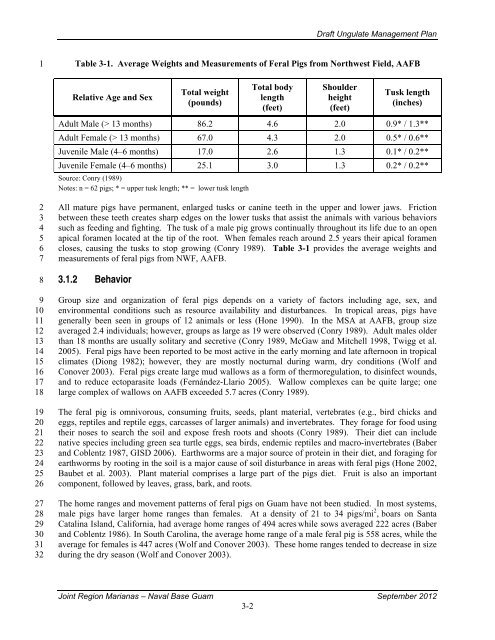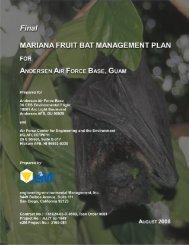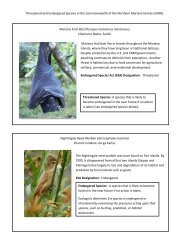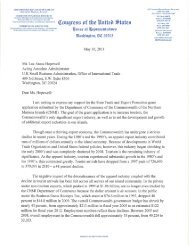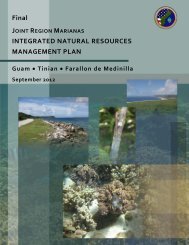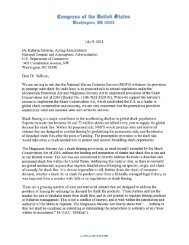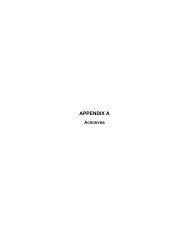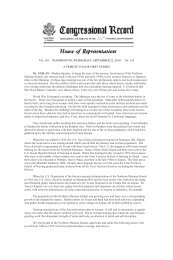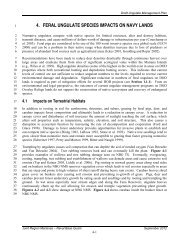Public Review JRM INRMP Appendices 092412-4
Public Review JRM INRMP Appendices 092412-4
Public Review JRM INRMP Appendices 092412-4
You also want an ePaper? Increase the reach of your titles
YUMPU automatically turns print PDFs into web optimized ePapers that Google loves.
Draft Ungulate Management Plan1Table 3-1. Average Weights and Measurements of Feral Pigs from Northwest Field, AAFBRelative Age and SexTotal weight(pounds)Total bodylength(feet)Shoulderheight(feet)Tusk length(inches)Adult Male (> 13 months) 86.2 4.6 2.0 0.9* / 1.3**Adult Female (> 13 months) 67.0 4.3 2.0 0.5* / 0.6**Juvenile Male (4–6 months) 17.0 2.6 1.3 0.1* / 0.2**Juvenile Female (4–6 months) 25.1 3.0 1.3 0.2* / 0.2**Source: Conry (1989)Notes: n = 62 pigs; * = upper tusk length; ** = lower tusk length234567891011121314151617181920212223242526272829303132All mature pigs have permanent, enlarged tusks or canine teeth in the upper and lower jaws. Frictionbetween these teeth creates sharp edges on the lower tusks that assist the animals with various behaviorssuch as feeding and fighting. The tusk of a male pig grows continually throughout its life due to an openapical foramen located at the tip of the root. When females reach around 2.5 years their apical foramencloses, causing the tusks to stop growing (Conry 1989). Table 3-1 provides the average weights andmeasurements of feral pigs from NWF, AAFB.3.1.2 BehaviorGroup size and organization of feral pigs depends on a variety of factors including age, sex, andenvironmental conditions such as resource availability and disturbances. In tropical areas, pigs havegenerally been seen in groups of 12 animals or less (Hone 1990). In the MSA at AAFB, group sizeaveraged 2.4 individuals; however, groups as large as 19 were observed (Conry 1989). Adult males olderthan 18 months are usually solitary and secretive (Conry 1989, McGaw and Mitchell 1998, Twigg et al.2005). Feral pigs have been reported to be most active in the early morning and late afternoon in tropicalclimates (Diong 1982); however, they are mostly nocturnal during warm, dry conditions (Wolf andConover 2003). Feral pigs create large mud wallows as a form of thermoregulation, to disinfect wounds,and to reduce ectoparasite loads (Fernández-Llario 2005). Wallow complexes can be quite large; onelarge complex of wallows on AAFB exceeded 5.7 acres (Conry 1989).The feral pig is omnivorous, consuming fruits, seeds, plant material, vertebrates (e.g., bird chicks andeggs, reptiles and reptile eggs, carcasses of larger animals) and invertebrates. They forage for food usingtheir noses to search the soil and expose fresh roots and shoots (Conry 1989). Their diet can includenative species including green sea turtle eggs, sea birds, endemic reptiles and macro-invertebrates (Baberand Coblentz 1987, GISD 2006). Earthworms are a major source of protein in their diet, and foraging forearthworms by rooting in the soil is a major cause of soil disturbance in areas with feral pigs (Hone 2002,Baubet et al. 2003). Plant material comprises a large part of the pigs diet. Fruit is also an importantcomponent, followed by leaves, grass, bark, and roots.The home ranges and movement patterns of feral pigs on Guam have not been studied. In most systems,male pigs have larger home ranges than females. At a density of 21 to 34 pigs/mi 2 , boars on SantaCatalina Island, California, had average home ranges of 494 acres while sows averaged 222 acres (Baberand Coblentz 1986). In South Carolina, the average home range of a male feral pig is 558 acres, while theaverage for females is 447 acres (Wolf and Conover 2003). These home ranges tended to decrease in sizeduring the dry season (Wolf and Conover 2003).Joint Region Marianas – Naval Base Guam September 20123-2


